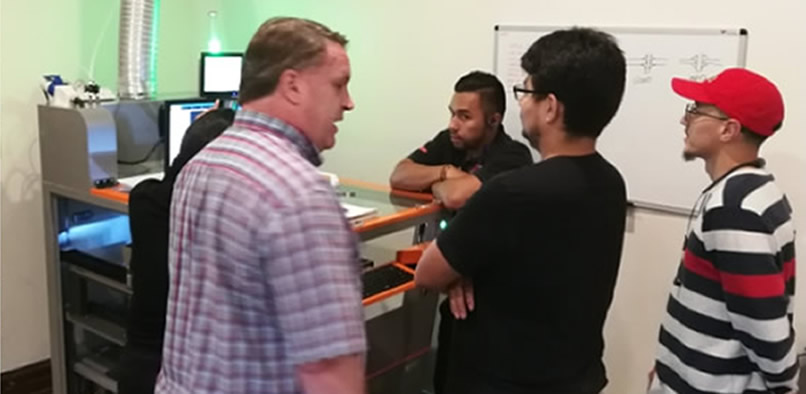Ant-i1 Offline Selective Soldering Machine: The Comprehensive Installation Training Guide
- 2019-06-12
- Company News
- Posted by: admin
In the rapidly evolving landscape of electronics manufacturing, efficient and precise soldering processes are imperative. For professionals in the electronics and PCB manufacturing industry, staying updated with the latest soldering technologies is not just an option but a necessity. The Ant-i1 offline selective soldering machine, standing at the forefront of innovation, represents a leap in the domain of selective soldering technology.
In this comprehensive post, we will walk through the intricate aspects of installing Ant-i1 offline selective soldering machines, ensuring a seamless transition into your manufacturing setup. This installation guide is a treasure trove of insights for electronics engineers, technology enthusiasts, and PCB manufacturers keen on harnessing the potential of this cutting-edge technology.
Section 1: Day 1 – Ant-i1 Setup and Basic Operation
The first day of installation and training is tantamount to laying the foundation of your selective soldering proficiency. Understanding the intricacies of the Ant-i1 machine and setting it up correctly can significantly impact the quality and efficiency of your soldering process.
Machine Unboxing and Initial Setup
Upon delivery, the meticulous unboxing of the Ant-i1 machine ensures that all components are accounted for. The initial setup involves assembling the machine frame, mounting the wave solder pot, and connecting essential power and data cables. Detailed documentation and an experienced engineer's oversight are crucial at this stage.
Configuring the Ant-i1 Parameters
Parametric calibration lays the groundwork for precision soldering. From setting the soldering temperature to configuring the speed and depth of the immersion, each parameter contributes to a soldering profile tailored to your specific requirements. The Ant-i1's user-friendly interface streamlines this setup process.
Electrical Safety Precautions
The use of molten tin in the selective soldering process requires a keen awareness of electrical safety measures. Insulation resistance testing and proper earthing of the machine are non-negotiable steps. Engaging with the machine's safety features and understanding emergency shutdown protocols ensures a secure operating environment.
Section 2: Day 2 – Customer Sample Soldering Test
On the second day, the Ant-i1 installation training progresses into the practical demonstration of its capabilities through a sample soldering test. This hands-on approach allows for real-time adjustments and fine-tuning of the machine's performance.
Material Preparation
Prior to the soldering test, preparing the materials is pivotal. Ensuring the PCB and components are clean and fluxed guarantees adhesion and thermal transfer. The quality of these pre-soldering preparations influences the integrity of the joint and overall product reliability.
Sample Soldering
During the soldering test, attention to detail is paramount. Observing the soldering process, inspecting for voids, and assessing the fillets' shape and smoothness are indicators of a successful solder joint. Iterative testing and parameter adjustments refine the soldering profile to align with the desired outcome.
Debugging and Troubleshooting
Encountering issues is a natural part of the testing process. Learning to diagnose and troubleshoot common soldering defects, such as bridging and incomplete wetting, empowers operators to think critically and act decisively. Engaging with technical support, when required, is a pivotal skill in a technician's repertoire.
Section 3: Day 3 – Operation and Maintenance Training
With the equipment set up and the soldering process validated, the third day is dedicated to training in Ant-i1 machine operation and maintenance. A deep understanding of these facets is crucial for sustained performance and longevity of the machine.
Operation Overview
Navigating the Ant-i1's control panel and understanding its display messages provides insights into the machine's status and ongoing processes. Learning the sequence of operations, including loading PCBs, running soldering cycles, and unloading, fosters efficiency and proficiency.
Regular Maintenance Checks
Performing regular maintenance checks is akin to preventative healthcare for your soldering machine. Cleaning the inlet filters, inspecting the machine for debris, and monitoring component wear is essential. Routine maintenance not only averts potential failures but also maintains soldering quality over time.

Consumable Replacement
Awareness of the Ant-i1's consumables and their replacement timelines is integral to uninterrupted operation. Electrodes, jaws, and pumps are consumable parts that require periodic replacement. Developing a schedule and keeping a stock of spare parts ensures that replacements are timely and minimize downtime.
Section 4: Days 4-5 – Customizing the Soldering Process
The final two days of installation training are dedicated to the customer's independent operation of the Ant-i1 machine. This independence is achieved through the customer's ability to program the soldering process in alignment with their project's specifications.
Understanding the Soldering Program
The programming language of the Ant-i1 enables the customer to define the soldering sequence step by step. Understanding the language syntax and semantics is crucial for specifying the immersion time, travel distance, and other critical parameters. Clarity in the program's intent translates into precise soldering actions.
Debugging Programs
Creating a program is not a one-time task; it's a dynamic process of continuous improvement. Analyzing the program's performance, identifying discrepancies, and revising the code is the cycle of improvement. The Ant-i1's built-in debugging features and graphical representation of the soldering profile aid in this iterative process.
Optimizing Soldering Programs
The final stage involves fine-tuning the programmed soldering actions for efficiency and quality. Overcoming challenges such as thermal exigencies and board layout complexities requires an analytical approach. By optimizing the soldering program, the Ant-i1 machine operates at its peak potential, delivering consistent and reliable solder joints.
Prev
Next
